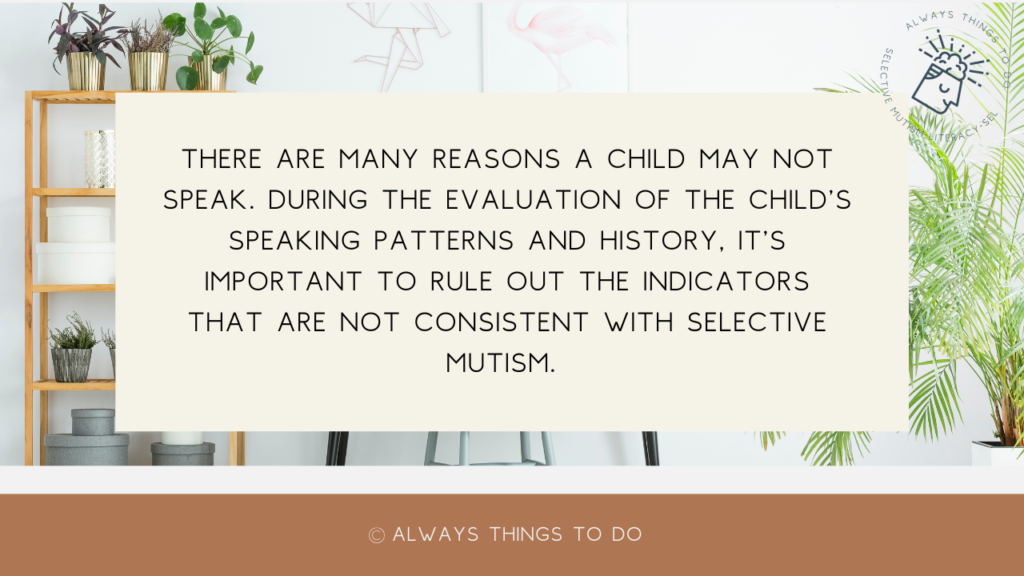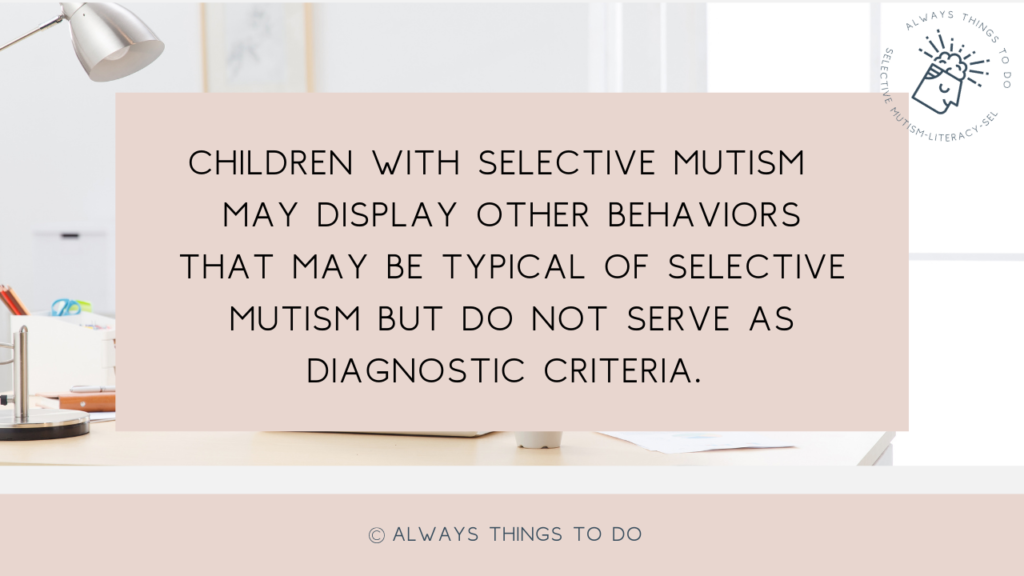Diagnosis of Selective Mutism: Simple Parent Guide and Steps to Take.

In this post, you will learn about:
- the steps towards the diagnosis of selective mutism
- some of the symptoms and behaviors of children with selective mutism
- the diagnostic criteria for selective mutism
Before my child was diagnosed with selective mutism, I saw nothing as a warning sign, let alone I knew that selective mutism anxiety disorder even existed.
In retrospect, it is possible now to pinpoint many observations that allow me to evaluate my child’s behaviors patterns and health profile against the diagnostic criteria that would point to her having selective mutism.
These are some of the behaviors my daughter displayed consistently before she received a diagnosis of selective mutism:
- clinginess
- reluctant eater
- sensitivity to textures, sounds
- hair sensitivity
- sensitive to physical touch (hugging)
- stubborn
- easily frustrated
- defiant
- moody
- bossy
- hiding running away when anxious
- reluctant to taking pictures
- difficulty making choices
- temper tantrums
- potty problems
But What Are Selective Mutism Symptoms?

Well, selective mutism symptoms are the behaviors mentioned above plus some others like:
- being emotional over small things
- dislikes corrections/ reminders
- fear of mistakes
- drama moments “I’m a bad kid,” “no one loves me.”
- jealousy towards mother
- mouth covering
- negativity
- uncomfortable when introduced to new people, teased, criticized
- difficulty with open-ended questions
- behaving very differently at home than in public, etc.
Check the resource “Selective mutism symptoms and behaviors” to see many of the selective mutism symptoms and behaviors (scroll to the bottom section “Latest Projects“).
Even though these behaviors go along with some patterns of selective mutism children usually display, none of them serve as the diagnostic criteria; therefore, it’s tough to see a child’s behavior as something pointing to a severe problem.
The only opportunity that gave us a hint about my child’s anxiety was her entering pre-K and facing the need to socialize outside of the home setting. And it was then when her behaviors matched the diagnostic criteria:
- a consistent pattern of not talking to adults and peers in school
- the behavior pattern lasted more than a month since the beginning of the school
- my daughter would stop talking and freeze when someone she did not talk to approaches
The bottom line, the only red flag for a parent to look for is this consistent pattern of not talking outside of the home setting (usually school).
So what’s next?
How is Selective Mutism Diagnosed?
First, diagnosis of selective mutism focuses on determining whether a child’s symptoms fit the diagnosis criteria for selective mutism:
These diagnostic criteria are:
- A child does not speak to peers, adults in school, and other social settings.
- A child usually speaks in a home or comfortable setting but shuts down (stops talking) when someone (whom the child does not speak to) approaches a child.
- A child displays a consistent pattern of not speaking to other people, which stretches beyond the “warming-up” period during the first months of school.
Who can make such a determination?
This is an excellent question since we are still discussing the stage when the child is possibly not diagnosed.
Therefore, a child’s parent’s or teacher’s observation is essential in determining the child’s unusual behavior.

It is also essential to know that certain behaviors DO NOT qualify as those pointing to selective mutism. Among those indicators are:
- a child has limited speaking in ALL the settings (HOME AS WELL)
- a child’s speaking habits are INCONSISTENT (a child speaks to teacher sometimes)
- a child does not talk at all
- a child suddenly stops speaking in a particular setting due to bullying, criticism, etc.)
- a child stopped speaking after a trauma
- a child has some other issues with speech and language development
When these indicators are present, the child must be evaluated for any other possible conditions that may or may not accompany selective mutism.
Second, once the child’s behavior profile fits the diagnostic criteria, a parent must find the proper treatment professional to diagnose a child and design a treatment plan.
It may vary from situation to situation and place to place, but the following professionals can potentially diagnose and treat selective mutism:
- Child psychologist
- Psychiatrist
- Psychotherapist
- Speech-language pathologist
- Occupational therapist
- Clinical social worker
Choosing the right person to work with your child is not an easy task.
A parent may, like my family, encounter difficulty even finding a qualifying professional in their area. On top of that, health insurance, in most cases, does not cover the treatment.
When searching for a treatment specialist for my child, I was motivated by two crucial factors:
- experience of the treatment specialist with selective mutism,
- personal qualities or, simply speaking, whether it is pleasant for me to work with this person because the journey of treating selective mutism is long.
By finding the right person, you invest in the successful future of the intervention for selective mutism.
You might be asking a question, “How do I know if the treatment professional is the right person?”
Great question.
These are some of the considerations to keep in mind:
A treatment professional…
- Is familiar with selective mutism and has experience with treating SM
- Is open to communicating with the child’s school and teachers
- Views SM as an anxiety disorder
- Does not label SM as autism, shyness, or behavioral problems
- Holds an interview where they ask about child’s upbringing, early development, lifestyle, relationships
- Can identify contributing and maintaining factors to support the diagnosis
- Acknowledges that treating SM means addressing the fear of speaking
What if the very first condition is not met and your treatment professional has little or no experience in diagnosing and treating SM?
I suggest choosing any therapist who works with anxiety children (selective mutism is an anxiety disorder, after all). Also, ask if the therapist is open to educating themselves about selective mutism to provide the best treatment to a child and work as a team with parents.
Finally, when you found your treatment professional, you need to know that the evaluation for selective mutism might be complex, intense, time-consuming because it includes many steps such as :
- Questionnaires about anxiety, behavior
- Diagnostic interview with a parent
- Direct observation of child’s behavior
- Observation in a classroom
- Video of a child
- Ruling out other disorders
- Teacher’s interview
- A session to discuss intervention /treatment and many others.
More prominent specialized program providers might take the former route to charge big bucks for selective mutism evaluation.
The reality of a single family is much more straightforward. Once a family finds a treatment professional, the assessment for selective mutism will take three simple steps:
- Diagnostic interview with a parent
- Direct observation of child’s behavior
- A session to discuss intervention /treatment
In the evaluation process and continuous intervention at home and school, the treatment professional will work with parents to observe, notice, and single out other disorders separate from selective mutism or accompanying selective mutism.
From my personal experience of working with the selective mutism treatment professional, I can confidently say that the success of selective mutism treatment, in the long run, is the result of the two critical factors:
- How knowledgeable and supportive the treatment professional is,
- The leading active role a parent plays in their child’s treatment process.
No amount of information and the level of financial responsibility a parent might have in the process of providing treatment for a child will give more reliable and transformative results than a parent taking consistent, everyday small steps to educate themselves about selective mutism and explore the tools to use in the selective mutism treatment.
If you liked the information in this post, make sure you explore other posts about selective mutism:
“Selective Mutism: How To Beat Crisis, Screaming, and Fear.”
Check out the expanding library of tools. Go to the selective mutism page and scroll to the bottom section, “Latest Projects.”
Connect with me on social media @alwaysthingstodo.




2 Comments
Pingback:
Pingback: